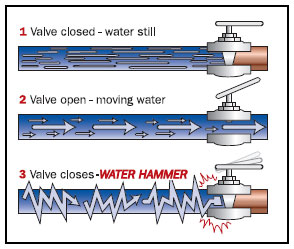Archives
Three ways to find loose pipes behind drywall
Water hammer is often caused by loose hot and cold water pipes.
Determining the location of those loose pipes in a stud wall can be challenging, but here are three methods that can help.

One method is to use a stud finder. A stud finder is a tool that can detect the location of studs, or the framing members, behind the drywall. Pipes are often run along the studs, so by finding the location of the studs, you can also determine the likely location of the pipes.
Another method is to tap on the wall and listen for a dull or hollow sound. Loose pipes will often make a rattling noise when they are tapped, whereas tight pipes will produce a solid sound. This method can be useful for locating the general area where the loose pipe is located.
A third method is to use a number of pipe location tools which are specifically designed to detect the location of pipes within walls. This collection of tools includes an electronic charge running through the pipe that emits a signal that is picked up by a sensor that’s run along the surface of the wall, which can help to locate the position of pipes with reasonable accuracy. Some listening devices can also help.
It’s important to note that it might be difficult to locate the exact spot where the pipe is loose, it’s recommended to hire a professional plumber to help you locate the problem and fix it.
Five ways to find water hammer in a stud wall.
In an earlier post we asked, “Do Hot and cold water pipes get water hammer?” Determining the location of loose pipes that cause water hammer in a stud wall can be challenging, as the pipes are typically hidden behind drywall or other wall coverings. However, there are several methods that can be used to locate the problem area:

- Sound: One of the most common ways to locate loose pipes is by listening for the sound of water hammer. This is the banging or knocking sound that occurs when a valve or faucet is quickly closed.
- Visual Inspection: If possible, removing a section of drywall or other wall covering in the area where the sound is heard can reveal the location of the pipes. You can also look for signs of water damage or staining on the wall or ceiling.
- Using a stud finder: A stud finder can be used to locate the studs behind the drywall, which will give you an idea of where the pipes are located.
- Tracer wire: If you have access to the attic or crawl space, you can trace the pipes with a tracer wire, which is a wire that is attached to the pipe and can be followed through the wall.
- Hiring a plumber: If you are unable to locate the problem area or are unsure about the best course of action, it is recommended to consult a plumber, who will have the knowledge and tools to locate the loose pipes and make necessary repairs.
Do Hot and Cold Pipes get Water Hammer?
Water hammer can occur in both hot and cold water pipes. It’s caused by a sudden change in the velocity of water flow, like when a valve or faucet is quickly closed. This sudden change in velocity can cause a pressure wave to travel through the pipe, creating the banging or knocking sound that is characteristic of water hammer.
The main cause of water hammer is water pressure that is too high, which causes the water to move too quickly through the pipes. This can happen in both hot and cold water pipes, and can be caused by a variety of factors such as worn out valves, loose pipe connections, or improper pipe installation.

In some cases, the problem is more likely to occur in hot water pipes because hot water is less dense than cold water, and therefore is more susceptible to changes in velocity. However, it is possible for water hammer to occur in both hot and cold water pipes, so it’s important to address the issue as soon as it is detected.
Read our earlier post What is Water Hammer and How to Stop It here
What is Water Hammer and How to Stop It!
Water hammer, also known as hydraulic shock, is a banging or knocking sound that can occur in pipes when a valve, a tap or faucet is quickly closed. The banging noise and vibrations from water hammer can be felt throughout a house and, in multi-storey buildings, because the water pipes pass through and serve every level, banging can be heard on building levels far from the source of the water hammer. It can be caused by a variety of factors, including high water pressure, improper pipe installation, or worn out valves. Some causes include, the fitting of a new dishwasher or clothes washing machine, or fast closing mixer style taps that shut down or stop the water flow quickly.

Stopping water hammer can be challenging, as it often requires identifying the root cause of the issue and then implementing a solution. Some common solutions include installing water hammer arrestors, which are devices that absorb the shock of rapidly moving water, replacing worn out valves, or adjusting the water pressure.
In some cases, the solution may be as simple as tightening loose pipe connections or securing loose pipes.
However, it is always recommended to consult a plumber if you experience water hammer, as they can diagnose the issue and recommend an appropriate solution.
